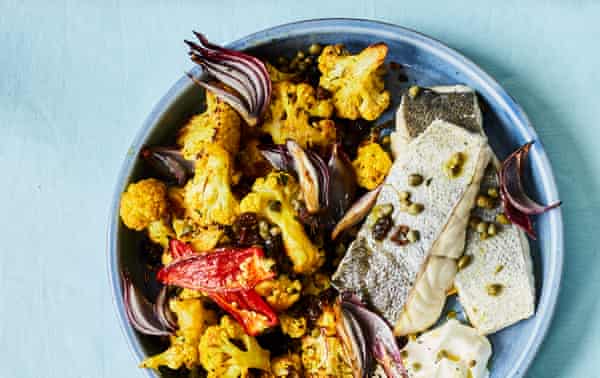Grilled mackerel fillets with rhubarb and bitter leaf salad
Mackerel is a British staple, and here, simply cooked with a crunchy bitter salad, sweet-sour rhubarb and creamy toasted almonds, it makes a brilliant light lunch.
Prep 5 min
Cook 25 min
Serves 2
2 sticks rhubarb (ideally forced, when in season)
1 tsp brown sugar
Juice and finely grated zest of 1 orange
2 heads yellow chicory
1 bunch watercress
2 large mackerel fillets (from a 300g fish)
Good-quality olive oil
Salt and pepper
20g toasted flaked almonds, to finish
Heat the oven to 200C (180C fan)/390F/gas 6. Cut the rhubarb into 3cm pieces, place in an ovenproof dish, add the sugar and the orange juice and zest, and bake for 12 minutes, or until just tender. Remove and leave to cool.
While the rhubarb is cooking, separate the chicory leaves and put in an bowl of iced water to keep them crisp and fresh. Pick the watercress and add to the endive bowl.
Now for the fish. Lay the mackerel fillets on an oven tray, drizzle with a little olive oil, season generously, then roast for 10 minutes.
Using a slotted spoon, lift the rhubarb into a medium bowl, then add the drained and dried chicory and watercress. Add a splash of olive oil to the juices in the rhubarb dish, whisk to combine, then use to dress the salad.
Lay each mackerel fillet on a plate, top with half the dressed salad, scatter the almonds liberally around and about, and serve.
Fillet of coley with curried cauliflower, capers and raisins

Coley is an underused but delicious fish. It has a soft texture, so needs punchy flavours and textures, such as in this robust dish that’s perfect for sharing.
Prep 5 min
Cook 25 min
Serves 2
½ bunch mint, picked
1 large cauliflower
1 red onion, peeled
1 tbsp mild curry powder
1 tsp fennel seeds
Good-quality olive oil
Sea salt and black pepper
2 x 180g coley fillets
1 red chilli, cut in half lengthways
50g raisins
50g capers
Greek yoghurt, to serve
Heat the oven to 220C (200C fan)/425F/gas 7. Roughly chop the mint, cut the cauliflower into large florets and cut the onion into eight pieces through the root.
Combine the curry powder, fennel seeds and mint in a bowl, add a good splash of olive oil and a generous pinch of sea salt, then add the cauliflower and toss to coat. Tip out on to a baking tray, keeping the florets spaced well apart, then bake for 15 minutes, until lightly charred and softened.
Meanwhile, put the coley fillets on an oven tray lined with baking paper, add the onion wedges and halved chilli, and season generously. Roast the fish for 12 minutes (if the fillets are larger or smaller, adjust the timings as necessary).
To finish the dish, add the raisins and capers to the roast cauliflower, toss to combine, then divide between two plates. Top with the fish and serve with a big spoonful of yoghurt alongside.
Fillet of hake with cockles and cider

I always cook hake on the bone, so it retains all that wonderful moisture, while the sweetness of the cockles helps to balance this dish. If you can’t find dried seaweed (it’s sold in most big supermarkets these days), use a couple of drained anchovy fillets instead.
Prep 5 min
Cook 25 min
Serves 2
50ml good-quality olive oil, plus extra to finish
350g hake steak, ideally from the middle of the fish and cut through the bone
50g butter
1 bay leaf
1 garlic clove, peeled
200g live cockles (or clams)
50g samphire
150ml cider
100ml creme fraiche
Zest of 1 lemon
10g dried seaweed (if available), ground to a powder
Heat the oven to 200C (180C fan)/390F/gas 6. Put the olive oil in a large ovenproof pan over a medium-high heat and, once hot, lightly brown the hake on both sides.
Add the butter, bay leaf and garlic to the pan, then transfer to the oven and bake for 10 minutes. Add the cockles, samphire and cider to the pan, cover the pan and return to the oven for five minutes more.
Remove the pan from the oven, lift out the hake and transfer to a warmed plate to rest.
Add the creme fraiche, lemon zest and seaweed powder, if using, to the juices in the pan, and reduce on a high heat, stirring all the time, for two minutes, until you have a thickish sauce. Pour over the hake and serve immediately.
Recipes by Adam Byatt, chef/co-owner of Trinity, London SW4
